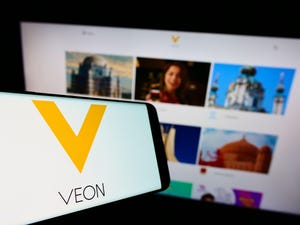Samsung, the open RAN star, has not escaped the 5G winter
Network revenues at Samsung plunged for the recent first quarter, according to a company report, and the immediate outlook is bleak.

It will have been missed by most Samsung watchers, like a soiled feather in a peacock's otherwise impeccable plumage, but the South Korean vendor's networks business posted a miserable result for the first quarter of 2024. As Samsung this week reported a surge in profit and headline sales growth, sharp-eyed observers of 5G wildlife will have spotted a fall in network revenues. It's a big one, too – in percentage terms lying somewhere between the drops seen at the comparable units of Ericsson and Nokia.
This can only be deduced by subtracting Samsung's gadget (what it calls MX) revenues from the gadget-and-networks total. During the first quarter of 2023, that basic calculation left revenues of 1.08 trillion South Korean won (US$780 million) on the networks side. A year later, they come to just KRW740 billion ($530 million). This year-over-year decline of 31% compares with constant-currency falls of 19% at Ericsson's main networks unit and 37% at Nokia's mobile networks business group.
Few will be shocked. The 5G subsector in which Samsung mainly plays is currently the victim of a "capex squeeze" by telcos following earlier rounds of investment. Operators in the US appeared to overindulge in 5G products in the aftermath of the pandemic. According to Ericsson and Nokia, they still have stock to deplete before they need to make another trip to the Ikea of 5G. That now seems likely to happen later this year (so the Nordic kit vendors say), but market research firm Dell'Oro expects global sales of radio access network (RAN) products to shrink 4% this year. Börje Ekholm, Ericsson's CEO, reckons that's "optimistic."
Still, some might have anticipated gains by Samsung this year in its challenger role. It seems to pop up everywhere as the main alternative to Ericsson and Nokia, especially where governments have banned Huawei and ZTE, the increasingly out-of-favor Chinese rivals. In the UK, Vodafone insists the substitution of Samsung for Huawei – with 2,500 sites due to be swapped by the end of 2027 – has moved significantly beyond the initial trial deployment of just 20 sites. Samsung is also occasionally visible in the network activities of several other European telcos, including different parts of Vodafone Group.
No Indian summer
Unfortunately, it has probably suffered a painful landing after especially vertiginous drops in the US and India, possibly Samsung's two biggest markets outside South Korea. Back in 2020, it reportedly scooped a $6.6 billion 5G contract with Verizon at Nokia's expense, but the US telco has recently taken a very large scythe to its capital expenditure budget. Its overall spending fell from $23.1 billion in 2022 to $18.8 billion in 2023, and from $6 billion in the first quarter of 2023 to $4.4 billion a year later.
India, meanwhile, seems to have treated its 5G rollout like an urgent mission. Europe's vendors benefited from the explosion of activity last year, with Ericsson calling it an "unprecedented rollout pace" and booking sales growth of 185%, to 31.2 billion Swedish kronor ($2.9 billion). But the telco foot inevitably slid off the gas in late 2023. By the time it published results for the first quarter of 2024, Ericsson was grumbling about "a reduction in capex investments in India." Sales categorized under "South East Asia, Oceania and India" consequently fell 42%, compared with the year-earlier quarter.
While Samsung breaks none of this out, it does appear to have lost RAN market share in India with the transition to 5G. In the 4G era, it had been the sole supplier to Reliance Jio, now India's biggest telco. And just as Europe's operators seem eager to seat Samsung next to their traditional kit vendors, so Jio wanted 5G roles for Ericsson and Nokia. A single-vendor arrangement obviously made sense for Jio when it was trying to build 4G quickly as a new entrant. As an established player deploying 5G, it has opted for a multivendor approach, splitting work between the three RAN suppliers.
The recent first-quarter sales drop of 31% looks bad compared with the 6% year-over-year decline for the same period of 2023. That said, Samsung's full-year sales in 2023 were just KRW3.78 trillion ($2.7 billion), 42% less than it made in 2022. And analysts expect some bottoming out to occur this year. Omdia, a Light Reading sister company, currently predicts RAN sales will shrink between 4% and 6% in 2024 after falling 11% in 2023.
Avenues for growth
Even so, Samsung has relatively few avenues for growth. It is effectively locked out of a Chinese market that awards nearly all contracts these days to Huawei and ZTE. India, the other country home to more than a billion people, is catching its breath after recent 5G exertions. Numerous countries in Africa and Latin America are still on cozy terms with the Chinese and not about to "rip and replace" their Huawei and ZTE networks.
As for North America, AT&T has just awarded a huge $14 billion contract to Ericsson that involves replacing Nokia equipment. This would seem to rule out any opportunity for Samsung except as a provider of radio units (RUs) linked to Ericson's RAN software. But open RAN collaboration of this nature seems improbable between the biggest vendors, whose RAN secrets are likely to be as fiercely guarded from rivals as Coca-Cola's famous recipe.
Ericsson and Samsung, moreover, are at odds on open RAN for massive MIMO, an advanced 5G technology. Samsung is willing to accept RUs without certain features provided these are included in the distributed units (DUs) that host RAN software. Ericsson is not.
Samsung could always make inroads with T-Mobile US, the other big US telco. But this would have to come at the expense of Ericsson or Nokia, already weakened and laying off staff. It has recently picked up some business with Telus in Canada, too. Outside this market, though, its best bet probably lies in Europe. Despite having two large homegrown vendors on their doorstep, operators in the region that have lost or risk losing access to Huawei seem determined to have a third option.
What's more, there has been much talk by Vodafone of a major tender, covering 170,000 sites in Europe and Africa, for RAN equipment. It kicked off the process this year and has already dropped numerous hints that Samsung is the frontrunner. The same template used for the Huawei swapout in the UK has now been carried into parts of Romania. Andrea Dona, Vodafone UK's chief network officer, calls it a "blueprint."
It is now a tried and trusted combo of vendors, with Samsung providing most RAN parts and software, Dell and Intel supplying servers and chips and Wind River responsible for the containers-as-a-service (CaaS) platform. Vodafone UK also claims to have recently combined a massive MIMO RU from Japan's NEC with Samsung's DU. What's unclear is how much flexibility there is to replace one of these players, whose arrangement seems to be solidifying like cement.
It's equally doubtful there really is a 170,000-site opportunity for Samsung in the imminent future. For starters, Vodafone has exited various sizeable markets since these tender ambitions were first disclosed in 2019, including Italy and Spain. It may be under some pressure to evict Huawei: The Chinese vendor accounted for as much as 60% of its European footprint before the launch of 5G, according to research by Strand Consult, and only Romania and the UK seem to have started swaps. But there would be no sensible commercial reason to jettison newish 5G equipment from Ericsson and Nokia. Amid a capex squeeze, and Vodafone's own financial difficulties, a 5G splurge would be counterintuitive.
One source who spoke with Light Reading confidentially regards the tender as the start of an extended process akin to painting the Golden Gate Bridge. In that sense, the last touches of paint have been applied to the end of the bridge and the crew is about to cross over and start the long job again.
Hey, big spender
Nevertheless, Samsung has a few things most other RAN challengers lack. The first is a comprehensive product portfolio, including RUs, software for DUs and CUs (central units, hosting other RAN functions), a service management and orchestration (SMO) platform and a RAN intelligent controller (RIC). It is also now positioning itself as a systems integrator, much as Ericsson and Nokia would do. That's critical because the one thing Samsung lacks – and has no intention of building – is that CaaS layer. Although Wind River shows up in most if not all its deals, Samsung says it is able and willing to partner with any CaaS provider.
Its products measure up well against those of more established vendors, according to telcos, and that is probably because Samsung can rely on the research-and-development (R&D) muscle of the bigger organization. Last year, Samsung spent KRW28.34 trillion ($20.6 billion) on R&D, 14% more than it invested in 2022.
During an industry event (FYUZ) in late 2023, AT&T technical executive Robert Soni estimated that Ericsson and Nokia spend a combined $5 billion annually on R&D in this area (their overall R&D spending came to about $9.3 billion last year). To match up, then, any rival would probably need to spend about $2.5 billion.
It's evidently doable for Samsung. But spending of that magnitude would account for nearly all its network revenues last year of $2.7 billion. Add in other expenses and the net result would be a significant loss. While this is purely speculative, it illustrates why survival in the 5G RAN market is such a challenge for most vendors. If anyone can prevail, it is probably Samsung.
About the Author(s)
You May Also Like












